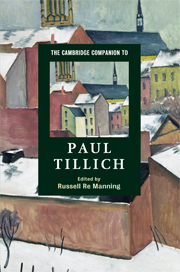Book contents
- Frontmatter
- Part I Standing within the theological circle
- Part II Theology of culture
- 8 Tillich’s analysis of the spiritual situation of his time(s)
- 9 Theology of culture and its future
- 10 Tillich’s theology of art
- 11 Tillich’s philosophy
- 12 Tillich’s ethics between politics and ontology
- 13 On the boundary of utopia and politics
- Part III Tillich in dialogue
- Bibliography
- Index
10 - Tillich’s theology of art
from Part II - Theology of culture
Published online by Cambridge University Press: 28 May 2009
- Frontmatter
- Part I Standing within the theological circle
- Part II Theology of culture
- 8 Tillich’s analysis of the spiritual situation of his time(s)
- 9 Theology of culture and its future
- 10 Tillich’s theology of art
- 11 Tillich’s philosophy
- 12 Tillich’s ethics between politics and ontology
- 13 On the boundary of utopia and politics
- Part III Tillich in dialogue
- Bibliography
- Index
Summary
It is widely acknowledged that Paul Tillich's engagement with the arts was the most sustained of any theologian of his generation. Indeed, more than that of any other theologian of the twentieth century, it is Tillich's theological encounter with art that has been the most profound, creative and influential (albeit often indirectly). Moreover, Tillich's reflections on the relationship between theology and art were crucial, indeed in many ways formative, for his wider project of a theology of culture, itself fundamental to his reformulation of theology as correlative to the concerns of his contemporaries. From our perspective, it is perhaps all too easy to overlook the dramatic - and profoundly unsettling - transformations that took place in the artistic spheres in Tillich's lifetime. Among other factors, new movements (e.g. impressionism, expressionism and modernism), new media (e.g. photography and film) and new estimations of the role of the artist (e.g. art for art's sake, readymades and popular art) all led to a need for a new theological engagement, one deeply rooted in the Christian tradition, inspired by the German Idealist tradition of art theory, and immersed within the new art of the avant garde. It is to Tillich's great credit that he took up this challenge and it is his great achievement that he gave to theologians and religious people a means of engaging with the new artistic situation of the twentieth century. Drawing on theological, philosophical and cultural analyses, Tillich gave his contemporaries a language with which they could enter into a genuine dialogue with the arts, both in terms of theological interpretation of art and of theological development through art.
- Type
- Chapter
- Information
- The Cambridge Companion to Paul Tillich , pp. 152 - 172Publisher: Cambridge University PressPrint publication year: 2009
- 1
- Cited by



